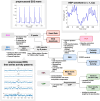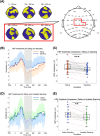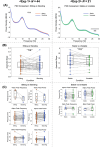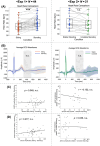Posture-Dependent Modulation of Interoceptive Processing in Young Male Participants: A Heartbeat-Evoked Potential Study
- PMID: 39957442
- PMCID: PMC11831245
- DOI: 10.1111/ejn.70021
Posture-Dependent Modulation of Interoceptive Processing in Young Male Participants: A Heartbeat-Evoked Potential Study
Abstract
Interoception, the internal perception of bodily states such as heartbeat and hunger, plays a crucial role in shaping cognitive and emotional states. Since postural control affects cognitive and emotional processing, exploring postural effects on interoception could help uncover the neural mechanisms underlying its effects on cognition and emotion. In this study, we aimed to investigate how different postures affect interoception by using heartbeat-evoked potentials (HEPs), which reflect the cortical processing of cardiac signals. Two experiments were conducted; Experiment 1 involved 47 healthy male participants comparing sitting and standing postures, and Experiment 2 involved 24 healthy male participants comparing stable and unstable standing conditions. HEPs were analyzed using cluster-based permutation analysis to identify statistically significant spatiotemporal clusters. In Experiment 1, significant clusters were identified over central electrodes (Cz, C1, C2, FCz, and FC1) within the post-R-wave interval of 304-572 ms, revealing significantly lower HEP amplitudes during standing compared to sitting [W = 80, p < 0.001, r = 0.62]. In Experiment 2, HEP amplitudes were significantly lower during unstable standing compared to stable standing [t(20) = 2.9, p = 0.0099, d = 0.62]. Furthermore, we found no significant correlations between HEP changes and physiological changes such as cardiac activity and periodic and aperiodic brain activity. These findings suggest postural differences modulate interoceptive processing, with standing postures attenuating HEP amplitudes, probably because of a redistribution of attentional resources from interoceptive to somatosensory (proprioceptive) and vestibular processing, necessary for maintaining standing posture. This study provides insights into the neural mechanisms underlying posture-interoception interaction.
Keywords: EEG; brain–heart interaction; heartbeat‐evoked potentials; interoception; posture.
© 2025 The Author(s). European Journal of Neuroscience published by Federation of European Neuroscience Societies and John Wiley & Sons Ltd.
Conflict of interest statement
The authors declare no conflicts of interest.
Figures






References
-
- Al, E. , Iliopoulos F., Nikulin V. V., and Villringer A.. 2021. “Heartbeat and Somatosensory Perception.” NeuroImage 238: 118247. - PubMed
-
- Awad, S. , Debatin T., and Ziegler A.. 2021. “Embodiment: I sat, I ‘Felt, I Performed—Posture Effects on Mood and Cognitive Performance.” Acta Psychologica 218: 103353. - PubMed
MeSH terms
Grants and funding
LinkOut - more resources
Full Text Sources
Medical
Miscellaneous

